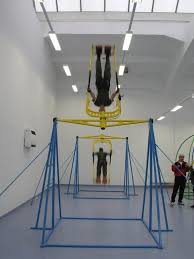2 hours ago, JoeJ said:You can fake graphics, but not physics.
Of cource. Becouse gaming collision response involve to mach black magic.
16 hours ago, JoeJ said:n that case feet contacts form a cycle and calculating a solution becomes hard
I know result exactly. It will complitely outclass human on task known as "make a higher posible volume of BIG-BADA-BOOOM sound" becouse it human-like.
1 hour ago, JoeJ said:But what if it is a walking robot standing with two feet on the ground
Human and human like-machine is staticaly unstable becouse it have only 2 support points and upper centre of mass. It have to jit anytime to keep balance dynamicaly. It is why imposible to sleep standing and why drunk guy's jittings have a very high magnitude - his response is to slow to keep balance accurate. Just get one you leg up and close your eyes. You will feel jitting by foot of other leg.Closing of eyes just turn off narrow position feedback sensing so you can feel jitting amplitude increased. So real robot will anytime seek stable vertical position but can not reach it, so jitting around it like human. Upper mass balance is unstable. Also it just unable to measure boxes properties that required to simulation.
Just imagine that you have a compass and goes directly to the North Pole. Each step you go into direction that compass needle shows. It how any gradient climb solvers works (both digital and analogue, including many human brain functions) - gradient show direction of shortest way to function extremum . But when you approached close to North Pole you step length exids exactly length that needed to make step directly to Pole. So you step over a Pole and now compass needle show opposite direction. You step again and it again exids needed length. It is jitter effect come from. It why unregulated actuator jitting around target point. To fight jitting effect you have to decrease step proportionally to your distance from Pole. It how any actuators works. But any mechanics (including human muscles) have minimal step length limit. To fight it limit you have to reach target point with given tolerance, that exids minimal step limit, and stop actuator. But you can not stop balancing a torso, becouse any error will be increased due to gravity. Balancing of torso causes jitting of actuator joined to it around target point. To fight it you have to jit actuator respectively to torso. It is why any precious work human have to made sitting on chair and have his elbows resting on supports - torso and legs just is to bad support for precious actuators movements.
Also it is why human-like robots is antiscience fiction that just become to fashion toy now. To extend human's abilities robot must have non-human like construction and brains, or better say autopilot( Intelligence is really bad thing for driving screws on convwyor and other similar works). So any nonstationar robot must have at least 3 support points and low profile to be staticaly stable and have ability to spend accumulator energy to solve tasks that it intended for, instead for play to balancing games. Just look at this video https://www.youtube.com/watch?v=z-mub6RXzAU. Actuator have same kinematics as human's hand. It clearly shows what support area and mass needed to get only actuator stable and what happends in case stand's support area is not enought. Couple days ago i has seen similar machine that has pulled out from ground 2-meters height concrete pillars together with meter of underound concrete base like mushrums. To done something like this human-like robot require size at least as Lord Megathron. Only task of real robotics is to make industrial machines and industrial processes unmaned, to liberate human from slavery of machines.









